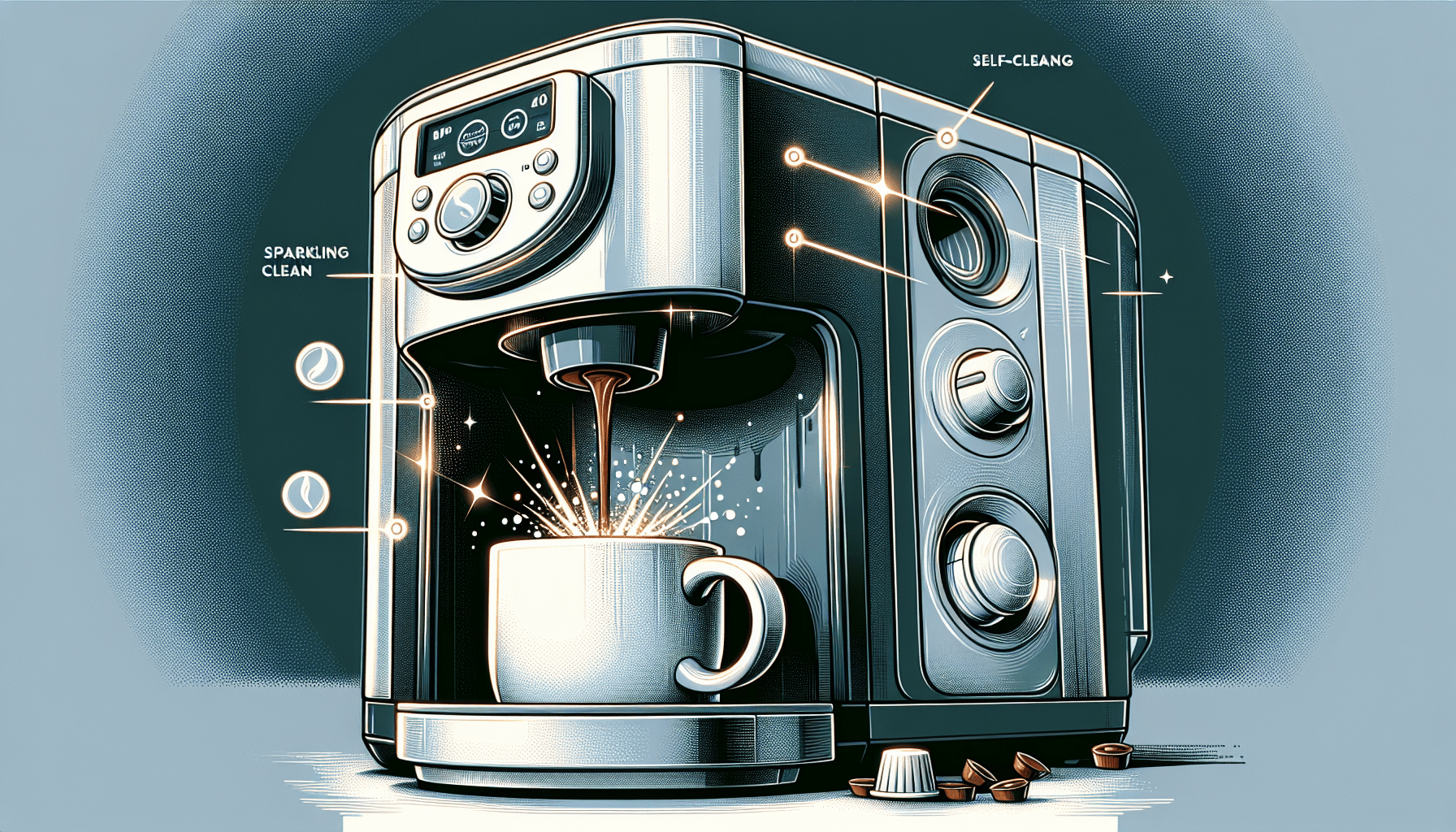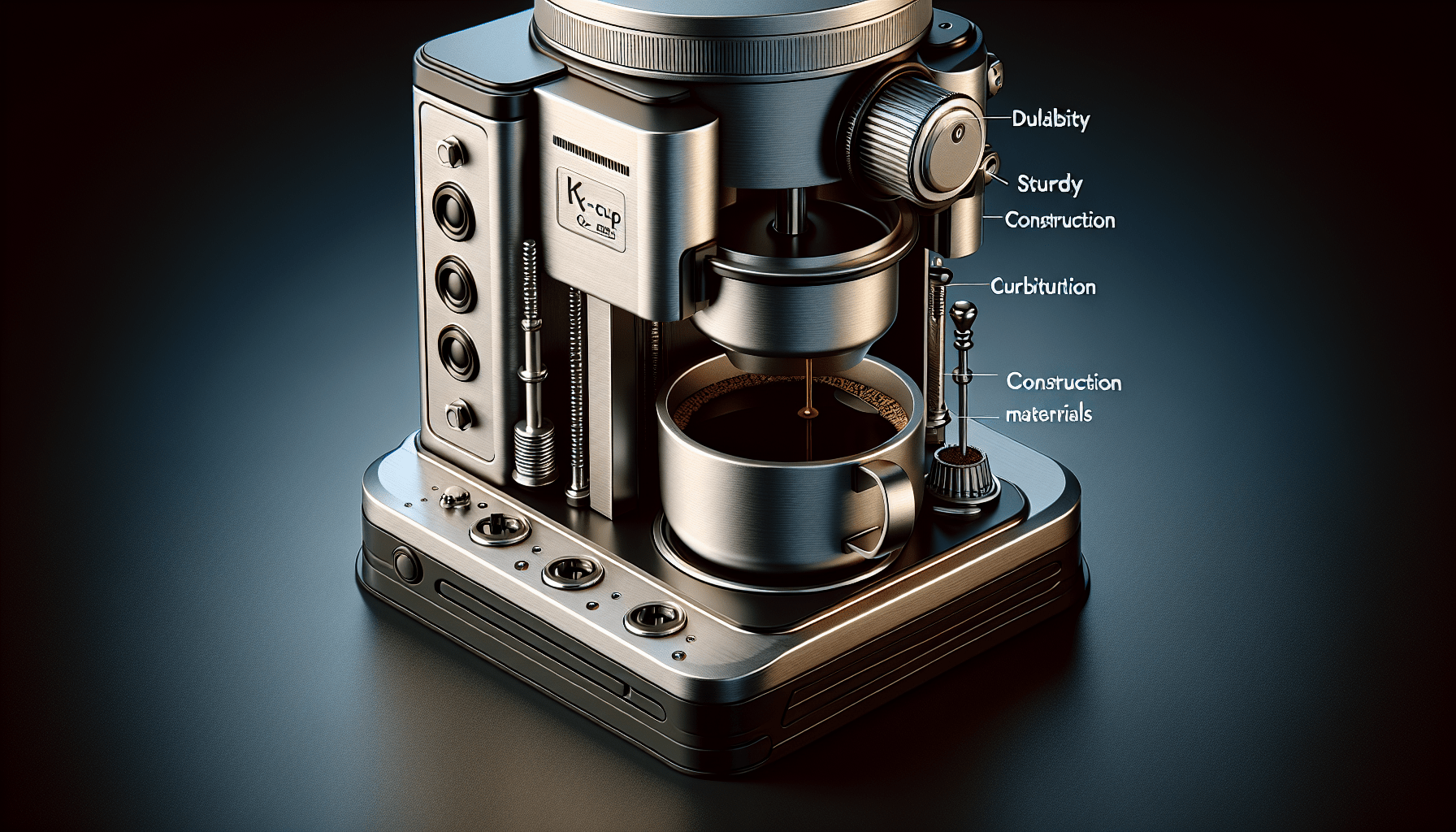Are you tired of spending precious time scrubbing and descaling your coffee maker? Well, you’ll be delighted to know that K-cup coffee makers may just have the solution you’ve been waiting for. With the convenience and ease of brewing a single cup of coffee, these machines also come equipped with a self-cleaning function that saves you the hassle of manual cleaning. Say goodbye to tedious maintenance and hello to a fresh, clean coffee maker every time you brew. So, let’s explore further and uncover the secrets behind the self-cleaning feature of K-cup coffee makers.
What is a K-cup coffee maker?
A K-cup coffee maker is a type of coffee machine that uses single-serve coffee pods called K-cups. These K-cups are small, pre-packaged, and filled with ground coffee, allowing for easy and convenient coffee brewing. K-cup coffee makers have gained popularity because they eliminate the need for grinding beans, measuring coffee, and dealing with messy filters. With a simple push of a button, you can have a freshly brewed cup of coffee in minutes.
How does a K-cup coffee maker work?
The working mechanism of a K-cup coffee maker is quite straightforward. It starts with loading a K-cup into the coffee maker, which is a small plastic capsule containing ground coffee. Once the K-cup is in place, you close the lid, and a small needle pierces the top of the K-cup. This needle punctures a hole through which hot water is injected into the K-cup, brewing the coffee. The brewed coffee then drips into a cup placed below the coffee outlet, ready to be enjoyed.
What are the benefits of using a K-cup coffee maker?
Using a K-cup coffee maker offers several benefits. Firstly, it provides convenience and saves time. With K-cups, there is no need to measure coffee or grind beans, making it ideal for those busy mornings. Secondly, K-cups provide a wide variety of coffee flavors and blends to choose from, catering to different taste preferences. Additionally, K-cup coffee makers are user-friendly, requiring minimal effort and expertise to operate. Lastly, since each K-cup is individually packaged, it ensures freshness and eliminates the need for measuring portions for a single serving of coffee.
Importance of cleaning a coffee maker
Why is it important to clean a coffee maker regularly?
Regular cleaning of a coffee maker is essential to ensure the longevity and optimal performance of the machine. Over time, coffee residue, oils, and minerals from water can accumulate inside the coffee maker, resulting in clogs and buildup. This can affect the taste and quality of the brewed coffee and may even lead to the development of mold and bacteria. Cleaning the coffee maker helps remove these deposits and ensures a clean and hygienic brewing process.
What can happen if a coffee maker is not cleaned properly?
If a coffee maker is not cleaned properly, several issues can arise. Firstly, the accumulation of coffee residue and oils can clog the machine’s brewing components, leading to a slower brewing time and subpar coffee extraction. Secondly, the presence of mineral deposits from water can cause scaling, affecting the heating element’s efficiency and potentially causing damage. Lastly, the neglected coffee maker becomes a breeding ground for mold and bacteria, posing health risks to the users.
Types of cleaning methods for coffee makers
There are various methods available for cleaning coffee makers, including manual cleaning, automatic cleaning, and self-cleaning.
Manual cleaning
Manual cleaning involves disassembling the coffee maker and cleaning each component individually. This method requires scrubbing the removable parts, such as the brewing basket, carafe, and filters, with warm soapy water. It is important to rinse the components thoroughly to remove any soap residue before reassembling the machine.
Automatic cleaning
Some coffee makers come with automatic cleaning cycles. These machines have built-in programs that run a cleaning solution through the machine, eliminating the need for manual cleaning. The user simply adds the cleaning solution to the water reservoir, activates the cleaning cycle, and the machine takes care of the cleaning process.
Self-cleaning
Self-cleaning coffee makers are equipped with a feature that automates the cleaning process. This feature allows the machine to clean itself, typically by running a cleaning solution or hot water through the internal components. Self-cleaning coffee makers offer convenience and ease in maintaining a clean machine without much effort from the user.
Does a K-cup coffee maker have a self-cleaning function?
Overview of self-cleaning features in K-cup coffee makers
Some K-cup coffee makers do have a self-cleaning function. This feature is designed to simplify the cleaning process for the user and ensure the machine remains in optimal condition. Self-cleaning K-cup coffee makers typically have a button or a menu option that initiates the cleaning cycle, which involves running a specialized cleaning solution or hot water through the internal components to remove any buildup or residue.
Do all K-cup coffee makers have a self-cleaning function?
While many K-cup coffee makers offer a self-cleaning function, it is not a feature found in all models. Some budget-friendly or basic K-cup coffee makers may not have this feature included. Therefore, it is important to check the product specifications or consult the manufacturer’s instructions to determine if a particular model has a self-cleaning function.
Benefits of a self-cleaning function
Convenience and time-saving
One of the major benefits of a self-cleaning function in a K-cup coffee maker is the convenience it offers. Instead of manually disassembling and cleaning the machine, the user can simply initiate the cleaning cycle with the touch of a button. This saves time and eliminates the need for extensive maintenance, making it ideal for busy individuals or those seeking a hassle-free coffee brewing experience.
Better coffee taste and quality
Regular cleaning, including the use of a self-cleaning function, helps maintain the coffee maker’s optimal performance. By removing coffee residue, oils, and mineral deposits, the machine can brew coffee at the right temperature and pressure, ensuring a better extraction of flavors and aromas. This results in a more enjoyable and flavorful cup of coffee.
Prevention of mold and bacteria growth
K-cup coffee makers, like any other coffee brewing equipment, can be susceptible to mold and bacteria growth if not cleaned regularly. The self-cleaning function prevents these issues by thoroughly cleaning the internal components, inhibiting the growth of harmful microorganisms. This not only ensures the cleanliness and safety of the machine but also protects the health of the user.
How does the self-cleaning function work?
Step-by-step process of the self-cleaning function
The exact process of the self-cleaning function may vary depending on the model, but it generally follows a few simple steps. Firstly, ensure that the water reservoir is empty and clean. Then, add the recommended amount of cleaning solution or water to the reservoir, as stated in the user manual. Next, start the self-cleaning cycle by pressing the designated button or selecting the appropriate option from the menu. The machine will then run the cleaning solution or hot water through the internal components, removing any buildup or residue. Once the cleaning cycle is complete, thoroughly rinse the water reservoir and run a brewing cycle with clean water to ensure any remaining cleaning solution is flushed out.
Frequency of self-cleaning
The frequency of self-cleaning depends on the individual usage and the manufacturer’s guidelines. It is generally recommended to perform a self-cleaning cycle every three to six months. However, if the coffee maker is used frequently or if it starts to exhibit signs of buildup or decreased performance, more frequent cleaning may be necessary. It is essential to read the manufacturer’s instructions for specific recommendations regarding the self-cleaning function.
Maintenance tips for a self-cleaning K-cup coffee maker
To maintain a self-cleaning K-cup coffee maker and ensure its longevity, the following maintenance tips should be followed:
Regular descaling
Descaling refers to the process of removing mineral deposits that accumulate over time. Even with a self-cleaning function, it is important to descale the coffee maker periodically. This can be done by using a descaling solution or a mixture of vinegar and water. Simply follow the instructions provided by the manufacturer to ensure the correct ratio of descaling solution to water and run the descaling cycle. Descaling helps maintain the optimal functioning of the coffee maker and extends its lifespan.
Cleaning the external parts
In addition to the internal components, it is important to regularly clean the external parts of the coffee maker. Wipe the exterior surfaces with a damp cloth or sponge to remove any accumulated dust, stains, or fingerprints. It is important to avoid using harsh chemicals or abrasive materials that could damage the coffee maker’s finish.
Replacing filters
If your K-cup coffee maker has a water filter, it is essential to replace it periodically. Over time, the filter can become saturated with impurities, affecting the taste and quality of the brewed coffee. Follow the manufacturer’s guidelines for how often to replace the filter to ensure optimal performance.
Other cleaning methods for K-cup coffee makers
In addition to the self-cleaning function, there are alternative cleaning methods that can be used for K-cup coffee makers:
Manual cleaning with vinegar
Vinegar is a natural cleaning agent that can effectively remove coffee residue and mineral deposits. To manually clean your K-cup coffee maker with vinegar, mix equal parts of white vinegar and water and pour it into the water reservoir. Run a brewing cycle without a K-cup, allowing the vinegar solution to clean the machine’s internal components. Repeat the process with clean water to rinse out any remaining vinegar taste.
Using specialized cleaning solutions
There are also commercially available cleaning solutions specifically designed for coffee makers. These solutions are formulated to effectively remove coffee oils and mineral buildup without causing any damage to the machine. Follow the instructions provided with the cleaning solution to ensure proper usage.
Deep cleaning techniques
For more extensive cleaning, especially if the machine has not been cleaned for an extended period, deep cleaning techniques can be employed. These techniques involve a thorough dismantling of the coffee maker, cleaning each component individually, and removing any stubborn stains or buildup. It is important to consult the manufacturer’s instructions for specific guidance on deep cleaning, as the process can vary depending on the model.
Common issues with self-cleaning function
While the self-cleaning function in K-cup coffee makers offers convenience, there are some common issues that users may encounter:
Malfunctioning of the self-cleaning feature
In some cases, the self-cleaning feature may experience malfunctions or errors, preventing the cleaning cycle from running as intended. This can be due to various reasons, such as a blocked water line or a faulty internal sensor. If the self-cleaning feature does not work properly, it is recommended to consult the user manual or contact the manufacturer for troubleshooting assistance.
Residual taste or odor
Despite the self-cleaning function, there may still be instances where a residual taste or odor is present in the brewed coffee. This can occur if the cleaning cycles are not performed frequently enough or if the machine’s internal components are not thoroughly rinsed. To alleviate this issue, ensure that proper cleaning cycles are followed, including rinsing the coffee maker with clean water after the cleaning process.
Conclusion
In conclusion, K-cup coffee makers offer a convenient and easy way to enjoy a freshly brewed cup of coffee. Cleaning and maintaining these machines, including utilizing a self-cleaning function, is crucial to ensure optimal performance, better coffee taste, and the prevention of mold and bacteria growth. Whether you choose a K-cup coffee maker with a self-cleaning function or opt for alternative cleaning methods, regular maintenance is the key to prolonging the lifespan of your coffee maker and ensuring a satisfying coffee experience. So, remember to keep your K-cup coffee maker clean and enjoy that perfect cup of coffee every time!



